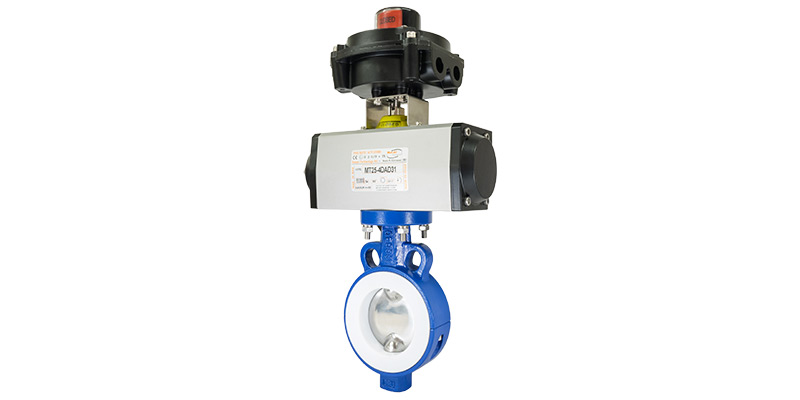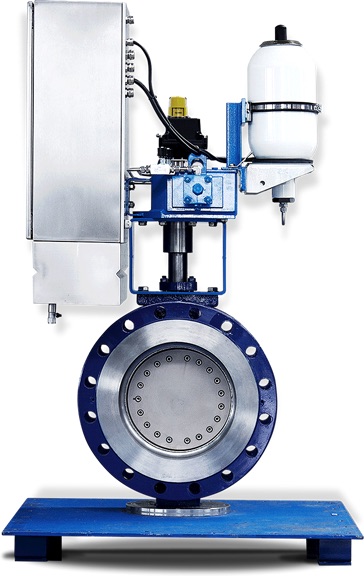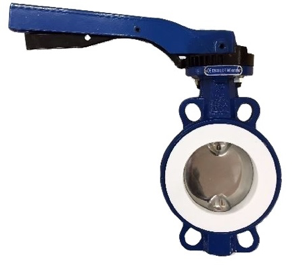
What are the main uses of butterfly valves?
Butterfly valves are compact, lightweight quarter-turn valves commonly used for starting, stopping and regulating flow. Offering a cost-effective alternative to many other valve types, particularly ball valves, butterfly valves are as effective as they are versatile. But how does a butterfly valve work, and what is a butterfly valve used for? Keep reading to find out.
What is a butterfly valve?
Butterfly valves are a type of quarter-turn, rotational valve used to stop, start and regulate flow. There are various types of butterfly valves, but what they all have in common are four main parts: body, disc (the so-called “butterfly”), stem and seat. Butterfly valves are categorised as either concentric or eccentric based on the stem’s location in relation to the centreline of the disc and the angle of the valve seat.
How does a butterfly valve work?
Butterfly valves function relatively simply. The butterfly element, more commonly referred to as the disc, is connected to a rod or stem, which rotates to open or close the valve. The valve can be opened or closed with a quarter-turn of the disc to enable or shut off flow. When the valve is closed, the disc sits perpendicular to the flow direction. This movement is thought to resemble the flapping of a butterfly’s wings, hence the name.
What are the advantages and disadvantages of butterfly valves?
Butterfly valves are a popular type of industrial valve for various reasons, but they aren’t suitable for all applications. Here are some of the standout advantages and disadvantages of butterfly valves.
Advantages
Butterfly valves offer the following advantages:
- Cost-effective
- Compact and lightweight
- Fast opening and closing*
- Available in large sizes
- Low pressure drop
- Minimal maintenance
* Larger gear-box-driven valves are easier to open but sacrifice speed.
Disadvantages
However, butterfly valves also have some disadvantages:
- Tricky to clean because they cannot be pigged
- Sometimes prone to cavitation and choked flow
- Throttling is only suitable at low differential pressures
Types of butterfly valves
Butterfly valves are categorised in various ways, including disc closure, connection, seat material and actuation method. Based on disc closure, the three types of butterfly valves are zero, double and triple offset. Connection options include wafer, lug, flanged, and butt weld ends. Seat materials tend to be metal or rubber, while actuation is either manual (hand-lever or gear) or automatic (electric, pneumatic or hydraulic).
What is a butterfly valve used for?
Butterfly valves are useful for applications involving large flows of liquids or gases at low pressures and for handling slurries. For larger pipe diameters, butterfly valves represent a lighter, smaller, more cost-effective option than ball valves. As such, butterfly valves can be found across numerous industrial applications, from water and wastewater treatment to oil and gas, chemical processing, and HVAC.
Let’s take a closer look at some of the most popular types of butterfly valves to gain a deeper understanding of their designs and functions. Each valve’s design and operating principle subsequently inform when and where you might choose to use them. For this article, we will focus exclusively on zero offset, double offset and triple offset butterfly valves.
Zero Offset (Concentric) Butterfly Valve
Zero offset butterfly valves feature a disc and stem centred in the valve’s seat and body. They employ a resilient soft seat (typically rubber) that forms the seal when the valve is closed.
Applications: Zero offset butterfly valves are recommended for liquid and gas applications up to 200°C (400°F) and 14 bar (200 PSI). Zero offset butterfly valves are suitable for use with food, chemicals, coatings and some solids.
Double Offset (Eccentric) Butterfly Valve
The stem of a double offset butterfly valve is positioned behind the disc’s centreline with another offset to one side. This creates a cam action that minimises friction, resulting in smoother opening and closing and longer service life.
Applications: Suitable for higher pressures where a high degree of control is required, these butterfly valves are commonly used in water, chemical, oil and gas, HVAC, and power generation applications.
Triple Offset (Eccentric) Butterfly Valve
Triple offset butterfly valves have a similar design to double offset varieties, except with the addition of a third offset in the shape of a conical-shaped seating surface. These metal-seated butterfly valves deliver smooth stroking and tight shut-off.
Applications: Suitable for high-temperature applications, triple offset butterfly valves are ideal for use with high-pressure and/or superheated steam and high-temperature gases and oils.
Butterfly valves from BM Engineering Supplies
BM Engineering offers an extensive selection of butterfly valves for all types of flow control applications. Featuring products from some of the industry’s most respected high-performance butterfly valve manufacturers, including INOXPA and Unitech, our butterfly valve collection is guaranteed to provide you with a reliable, durable and cost-effective butterfly valve – no matter what your application.
For more information about butterfly valves or to discuss your application requirements, please contact our sales team today on 0141 762 0657 or email sales@bmengineering.co.uk.



